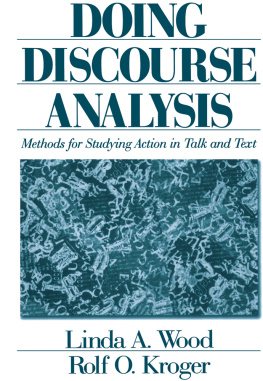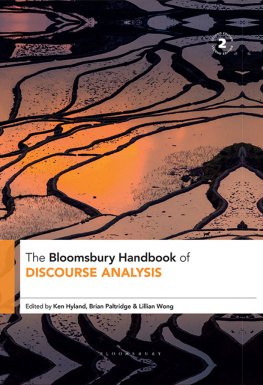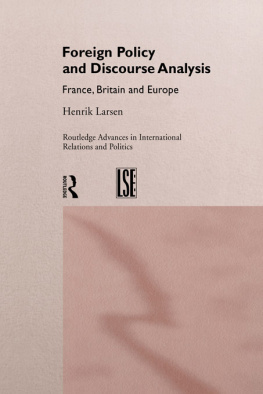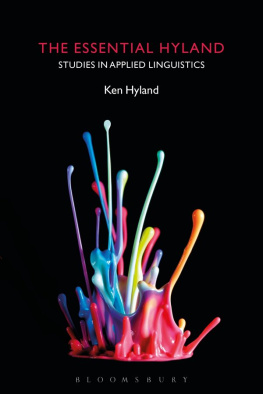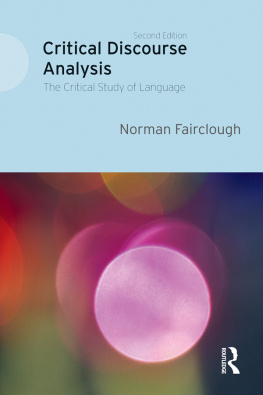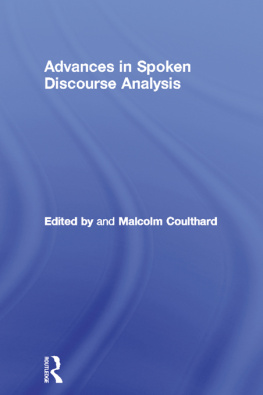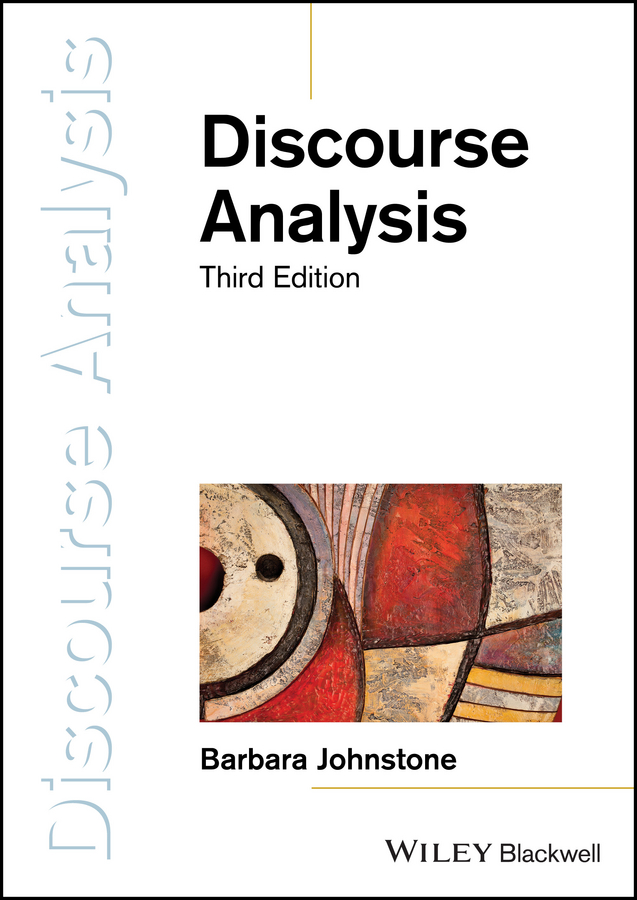
Table of Contents
List of Tables
- Chapter 04
- Chapter 07
List of Illustrations
- Chapter 01
- Chapter 02
- Chapter 03
- Chapter 04
- Chapter 06
- Chapter 07
Guide
Pages
Introducing Linguistics
This outstanding series is an indispensable resource for students and teachers a concise and engaging introduction to the central subjects of contemporary linguistics.
Presupposing no prior knowledge on the part of the reader, each volume sets out the fundamental skills and knowledge of the field, and so provides the ideal educational platform for further study in linguistics.
- Andrew Spencer Phonology
- John I. Saeed Semantics, Fourth Edition
- Barbara Johnstone Discourse Analysis, Third Edition
- Andrew Carnie Syntax, Third Edition
- Anne Baker and Kees Hengeveld Linguistics
- Li Wei, editor Applied Linguistics
Discourse Analysis
Barbara Johnstone
Third Edition
This third edition first published 2018
2018 John Wiley & Sons, Inc.
Edition History
Blackwell Publishers Ltd (1e, 2002); WileyBlackwell (2e, 2007)
All rights reserved. No part of this publication may be reproduced, stored in a retrieval system, or transmitted, in any form or by any means, electronic, mechanical, photocopying, recording or otherwise, except as permitted by law. Advice on how to obtain permission to reuse material from this title is available at http://www.wiley.com/go/permissions.
The right of Barbara Johnstone to be identified as the author of this work has been asserted in accordance with law.
Registered Office
John Wiley & Sons, Inc., 111 River Street, Hoboken, NJ 07030, USA
Editorial Office
9600 Garsington Road, Oxford, OX4 2DQ, UK
For details of our global editorial offices, customer services, and more information about Wiley products visit us at www.wiley.com.
Wiley also publishes its books in a variety of electronic formats and by printondemand. Some content that appears in standard print versions of this book may not be available in other formats.
Limit of Liability/Disclaimer of Warranty
While the publisher and authors have used their best efforts in preparing this work, they make no representations or warranties with respect to the accuracy or completeness of the contents of this work and specifically disclaim all warranties, including without limitation any implied warranties of merchantability or fitness for a particular purpose. No warranty may be created or extended by sales representatives, written sales materials or promotional statements for this work. The fact that an organization, website, or product is referred to in this work as a citation and/or potential source of further information does not mean that the publisher and authors endorse the information or services the organization, website, or product may provide or recommendations it may make. This work is sold with the understanding that the publisher is not engaged in rendering professional services. The advice and strategies contained herein may not be suitable for your situation. You should consult with a specialist where appropriate. Further, readers should be aware that websites listed in this work may have changed or disappeared between when this work was written and when it is read. Neither the publisher nor authors shall be liable for any loss of profit or any other commercial damages, including but not limited to special, incidental, consequential, or other damages.
Library of Congress CataloginginPublication Data
Names: Johnstone, Barbara, author.
Title: Discourse analysis / by Barbara Johnstone.
Description: Third edition. | Hoboken, NJ : John Wiley & Sons, [2018] | Includes bibliographical references and index. |
Identifiers: LCCN 2017026920 (print) | LCCN 2017029090 (ebook) | ISBN 9781119257707 (pdf) | ISBN 9781119257714 (epub) | ISBN 9781119257691 (pbk.)
Subjects: LCSH: Discourse analysis.
Classification: LCC P302 (ebook) | LCC P302 .J64 2017 (print) | DDC 401/.41dc23
LC record available at https://lccn.loc.gov/2017026920
Cover image: Spiderstock/Gettyimages
Cover design: Wiley
To my teachers
List of Figures
| How discourse is shaped by its context, and how discourse shapes its context. |
| Two magazine advertisements for Splendors of Ancient Egypt. |
| Structure of a Splendors artifact label. |
| Some other areas of choice. |
| Conventions for conversational implicature (adapted from Grice, 1975). |
| Functions of discourse (adapted from Jakobson, 1960: 353, 357). |
| Ways of keying verbal performance (Bauman, 1977: 16). |
| Lexical cohesion. |
| Situational parameters of variation. Source: Adapted from Biber, 1994: 401. |
| Pittsburghese mug. Source: Photograph by Barbara Johnstone. |
| Features of orally transmitted knowledge. Source: Adapted from Ong, 1982. |
| Dimensions of textual variation. Source: Adapted from Biber, 1988. |
| Laminating gesture. Source: Adapted from Moore, 2008, p. 396. Sketches by Arty Johnstone. |
| Pennsylvania Dutch question intonation. Source: Adapted from Fasold, 1980. |
| Barbershop. Source: http://www.lensicle.com/file/manhairtrimmedbarber/, accessed Nov. 26, 2016. Used under CC0 license. |
List of Tables
| Units of discourse. |
| A model of conversational turntaking. |
| Some features of planned and unplanned discourse. Source: Adapted from Ochs, 1979b; Chafe, 1982; Tannen, 1982a. |
| Analyzing visual discourse. Source: Adapted from Kress and Van Leeuwen, 1996. |
Preface
This book is intended to be a firstlevel text for undergraduates and beginning graduate students taking their first (or only) course about discourse analysis. The subject matter of discourse analysis is vast language in use, as Brown and Yule (1983) put it, utterances, according to Schiffrin (1994), verbal communication for Renkema (2004) and most discourse analysts would be hard pressed to describe what, if anything, makes discourse analysis a discipline. Yet, discourse analysis is implicitly treated as if it were a discipline in texts that are organized as a series of overviews of research topics (institutional discourse, discourse and gender, narrative, media discourse, and so on) or theories (pragmatics, Conversation Analysis, politeness theory, and so on). The approach I take in this book is different. I treat discourse analysis not as a discipline (or as a subdiscipline of linguistics) but as a systematic, rigorous way of suggesting answers to research questions posed in and across disciplines throughout the humanities and social sciences and beyond. In other words, I see discourse analysis as a research method that can be (and is being) used by scholars with a variety of academic and nonacademic affiliations, coming from a variety of disciplines, to answer a variety of questions.
For this reason, this book is meant to encourage students not to think of discourse analysis as a collection of facts or canonical studies or as a body of theory. As we will see, discourse analysts set out to answer many kinds of questions about language, about speakers, and about society and culture. However, they all approach their tasks by paying close and systematic attention to particular situations and particular utterances or sets of utterances. This book attempts to separate the techniques of discourse analysis clearly from its results, trying to make sure that students understand and practice the former before concentrating on the latter. This will, I hope, help alleviate a problem I have had again and again in teaching discourse analysis that of ending up with students who are fascinated by the results of sensitive analyses of discourse but unable themselves to perform analyses that go much beyond paraphrase. Discourse analysis, as I approach it here, is an openended heuristic, a research method consisting of a set of topics to consider in connection with any instance of discourse. This heuristic can help insure that discourse analysts are systematically paying attention to every possible element of the potential meaning of a stretch of talk or writing: every kind of context, every resource for creativity, and every source of limitation and constraint on creativity. My focus is thus less on providing detailed descriptions of the results of discourse analysts work than on asking students to think systematically about a variety of sources of constraint on and creativity in discourse, a variety of reasons why spoken utterances and written texts have the meanings and uses they do. Discussion questions which, in many cases, ask readers to think about what they and other people in their field do or might do with discourse analysis, as well as ideas for small research projects using discourse analysis, are interspersed throughout the chapters.
Next page

